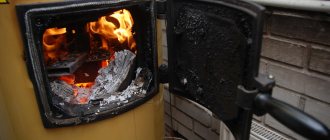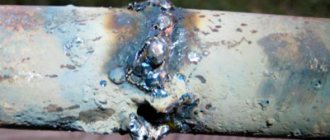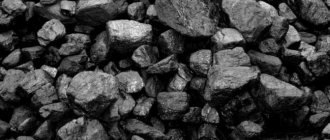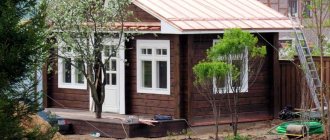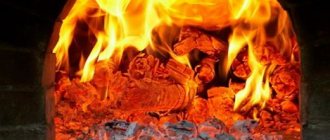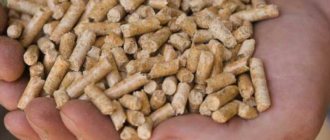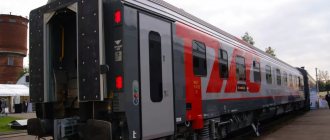With the arrival of cold weather, every owner of a heater or stove asks the question: how to light the stove at home? The diligent owner stocks up on raw materials a year before the heating season. During this time, they dry in a woodpile, where they are protected from rain and snow. The shed should be well ventilated to prevent the wood from rotting.
There are times when you didn’t prepare in advance, but the camera needs to be lit at that moment. You only have imported material that is not prepared for heating a house or bathhouse. You did not have the opportunity to prepare dry dead wood. This is not a reason to be upset, we will look at several methods of ignition.
How to light a stove with raw wood - without special tools
Many people mistakenly think that they can handle raw timber with kerosene, diesel fuel or gasoline. You just have to splash a little liquid into the fireplace. This will lead to fatal consequences, including setting the premises on fire. You can also be poisoned by combustion products if you do not open all windows and doors wide open. There are other ways, you just have to be patient, because the procedure will take a lot of your time:
- It’s good if you have dry logs left over from last year. Then you should first divide them with an ax or knife into thin chips. Crumple up more paper, put prepared torches on it, and light it. Let the fire burn. At this time, prick the wet bars as thinly as possible. And carefully place them on the hearth like a hut. Do not try to speed up the process; do not add all the logs at once. This will lead to smoke in the room, the formation of soot and soot in the pipe. Once the red coals appear, you can place thicker dies there. You just need to make sure that there is a small distance between them to allow oxygen to get into the fire. Next, follow the method: your hand can’t stand the heat over the fire, so it’s time to add the rest.
- How to heat a stove with raw wood? A little harder and longer. Many stokers know from experience that smoke and soot will be present here. But as soon as the first batch of brushwood flares up, you can add wet wood. There will no longer be any difference between dry and wet fuel. The heat transfer from the fire will be the same. Even people deliberately delay the combustion process by throwing raw material into the firebox in order to increase the period of time for adding a new batch. Because dry dies light up quickly, but also burn out instantly. And you will constantly think about maintaining heat in the house, and run to the unit again and again.
Why damp and wet firewood does not ignite
How much worse is damp firewood? This issue worries many, if not all. There is an opinion that wet firewood is worse in terms of calorific value than dry firewood. From my own experience I can say that damp wood burns very poorly.
From a conversation on a construction forum: – If a stove-stove with dry wood heated the room up to 20 degrees, then with wet wood it barely reached 15. And, the burning time is still the same (if you count by the number of firebrands). A very good option (if there is no dry firewood) is to dry the fuel directly by the stove, at least for a couple of days.
The effect is very noticeable. If there is absolutely no dry firewood, you have to dilute it slightly dried, and then add it in its raw form. Damp wood burns poorly, but for a long time. They heat at half strength, but they burn longer. Why this is so is not clear. – The energy (heat) of wood combustion is spent on heating the excess moisture (water) contained to the boiling point and evaporation of this water
How to heat a stove with raw wood: basic techniques
First you need to figure out what type of wood is suitable for heating the room. Experts say that non-coniferous wood is best suited for this purpose. Pine and spruce, when burned, release resin, which is deposited on the walls of the chimney. They also do not maintain optimal temperature.
Depending on your geographical location, you choose the timber that grows in the immediate vicinity of you. We will give a brief description of the more relevant categories of raw materials:
- Pine. It has a high degree of combustion, releases a huge amount of resin, and is characterized by internal voids. When ignited, sparks fly and the log explodes into separate pieces.
- Spruce. They heat it when absolutely necessary, as it brings little heat, smokes, and smolders. But it pricks easily.
- Alder and aspen .
If you heat the stove with raw wood from these species, you will solve another problem at the same time. They are the only ones that clean the chimney of tar and soot. - Poplar. The cheapest wood. It does not produce much heat, burns out very quickly, and requires constant presence near the heater. You can’t heat a bathhouse to the optimal temperature.
- Birch. Just like poplar, it burns quickly and has little heat transfer. In this case, a constant flow of air is required, otherwise the birch logs will smoke and not produce heat. It is better not to use wet dies from these rocks, because the released resin will quickly damage your heating system. You will have to call a specialist to clean out the clogged smoke exhaust system.
- Oak. Optimal type for heating. It burns for a long time and produces a lot of heat. The only negative is that it pricks hard when dry. Therefore, it must be processed immediately after felling.
- How to light a stove from an apple, pear or other fruit tree? This question is asked by owners of private houses, summer cottages and garden plots. There is no need to throw away cut logs. They provide excellent heat transfer. In addition, the room is filled with a fruity aroma, which has a beneficial effect on people’s well-being.
- Linden and maple. They are convenient and easy to prepare into bars, but do not produce charcoal when burning, leaving only crumbly ash. And this affects heat transfer. These breeds require special attention from the heater owner; logs need to be added every half hour.
- To heat the living space, you can use peat briquettes and pellets made from pressed sawdust. In Asian countries, dung is widely used.
Rules for lighting a metal stove
Metal stoves are common both in homes and in bathhouses. The difference between a sauna heater is that its design contains a direct-flow outlet for increased safety. To properly heat a sauna heater, you should take into account the rapid combustion of the primary filling due to the abundant air flow
At the same time, it is important to promptly turn over burning fuel so that large unburned coals do not form.
Metal stoves installed in residential buildings have a curved smoke exhaust system for long-term heat retention. The rules for igniting wood in such stoves concern the ban on the use of liquid flammable mixtures. Otherwise, you should follow the recommendations as when lighting conventional stoves.
A few words should be said about the peculiarities of lighting brick fireplaces and long-burning stoves. In the first case, more firewood will be required for the initial and main ignition, as well as time for kindling. In the second case, the features of the combustion chamber require a longer combustion process than in conventional fireboxes, so firewood should be added at intervals of not every 2.5 hours, but every 4 hours.
https://youtube.com/watch?v=9NVj23BL9vM
Procedure for kindling
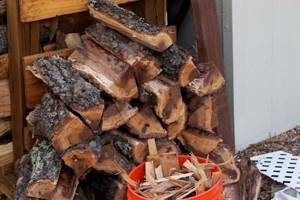
Experienced stokers don’t have a question: how to quickly light a stove with raw wood? They elevated their work to the level of art. Because they know that wood gives off heat at a temperature of 300 to 400 degrees. And to heat rooms it is not enough to maintain a fire at 50 °C. This will only lead to smoke.
For an optimal kindling process, experts give several recommendations on how to reduce fuel consumption and increase heat:
- It is preferable to prepare raw materials that are five centimeters smaller than the combustion chamber.
- The size of the chopped log should be approximately the same.
- It is necessary to remove all burnt ash and coals from the furnace, and clean the grates from tar and soot.
- Then check for the presence of traction, first light the paper. And look at the direction of the smoke. If everything is in order, then it will go inside the firebox, and not out.
- We begin to make a seed: we place two logs parallel to each other, and between them is a crumpled piece of paper. Sawdust and shavings are poured on top. Two more beams are placed on top of this structure. Next, we set it on fire with the blower open so that there is additional air supply.
- When the heater begins to hum, then close the lid, but not completely.
This method is suitable for dry logs, but how to light a stove with wet wood? Stokers give their recommendations:
- Chop the block lengthwise into several pieces.
- If it is a birch tree, then remove the bark, as it will interfere with the kindling.
- From the inside, pinch the splinters, which are not so wet.
- There should be a large number of such chips. Because they will have to maintain the fire for 15-20 minutes until the firebox warms up.
- Place the prepared splinters in a “hut” on the crumpled paper.
- When the fire is burning properly, you can then add thin dies.
- Wait another twenty minutes, then add the raw logs to the hot coals.
- Cover the vent and monitor the combustion process.
- Don't let the fire go out, otherwise you'll have to do it all over again. Periodically add wood to the flame.
- Watch the draft so that smoke does not enter the room.
Types of wood by moisture level
It happens that the firewood is damp or simply not there, and the house needs to be warmed up. Then freshly cut trees are used. It is better if it is birch or aspen. Oak may also work, but it will be difficult to split. The speed and quality of kindling depends on the moisture content of the firewood.
Wood is divided into a number of categories based on moisture level:
0% - completely dry. It is rare due to the natural humidity of the air indoors or outdoors. From 7 to 20%
This importance can be achieved by drying the tree in a special chamber or by keeping it in a warm house all winter. 20 -45%, normally dried wood from a woodpile. 45-80% is fresh firewood, just cut. Winter and autumn firewood will be more humid
It is difficult to heat with them; you need to follow the kindling technology. Wood that has been in water for a long time has more than 80% humidity. It is generally impossible to drown like this.
How to speed up kindling
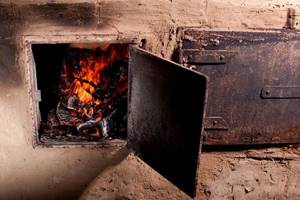
Many hunters give advice on how to quickly dry firewood. They saved more than one frozen life in extreme conditions. There are prepared woodpiles in the parking lots, only in the open air, where rain falls on them. Accordingly, during winter, they freeze and become covered with ice. But this does not prevent hunters from warming up. They use several old folk techniques:
- It is necessary to clear the lumber of snow.
- Chop into small slivers.
- Melt the unit, as we wrote earlier.
- Just throw two handfuls of coarse table salt onto the paper. It will absorb excess moisture.
- If you don’t have a newspaper at hand, take a piece of plastic or roofing felt. You will spend a little more time lighting these items.
- If this is not the case, then vegetable oil will help you. You can pour a tablespoon onto the wood chips. Or fill a liquid bottle with sawdust, shavings, newspaper or dry rags. And also put it in the fire.
- Use diesel fuel and gasoline. But there is no need to splash them into the combustion chamber. You need to soak a piece of rag in the liquid and place it next to the wood chips. Then you will avoid a fire hazard.
Of course, you can suffer for a long time with an old heater or stove, but in the end you will achieve results. But will it give you all the heat, will it be reliable in operation, will it withstand the load of wet wood? Before building a house with stove heating, you should contact specialized stores for advice.
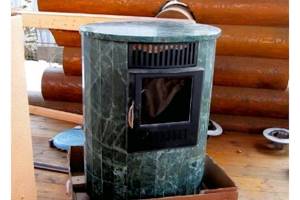
Hardwood firewood
To make a choice, you need to consider each type of firewood separately.
Birch firewood
This type of wood has special qualities, so it is often used to fire saunas. The heat that birch gives is a disinfectant for the room and releases the fragrant aroma of a real Russian bath. In addition, it is also credited with medicinal properties that help speedy recovery during a cold. But birch firewood cannot be kept in woodpiles for more than two years - it loses its properties and begins to deteriorate, turning into dust.
Birch firewood
Dried birch wood, as well as its bark, has a high content of tar, which is a carbon compound, so firewood quickly ignites and burns together, without leaving behind a large amount of ash. Splinters made from dry birch logs are used to light other firewood made from heavier wood. When burning, birch gives off good heat transfer, releasing heat of such intensity that is 22-25% higher than the flame from aspen or pine wood.
Oak
Oak wood for heating a stove is considered an elite fuel, so it is quite expensive. Oak is a hard wood, it burns for a long time and has very good heat transfer, surpassing even birch firewood in this quality. For heating, middle-aged trees are harvested - they are the ones that have the properties described above. Oak firewood produces intense heat and spreads a tart forest aroma throughout the heated room, and this is especially felt if they are used to stoke a fireplace. The steam released by oak when burned, just like birch, has long been considered medicinal by people, especially for children.
Oak firewood
It is interesting that famous Italian restaurateurs and cafe owners, adhering to ancient traditions, use exclusively oak firewood to prepare real pizza, although such wood is rare and has a fairly high price. Firewood from the trunks of fruit trees, such as a pear or an apple tree of a certain age, has somewhat similar qualities, but it is quite difficult to find them in large quantities.
Alder firewood
Alder firewood is popular because it does not require special conditions for drying - it reaches the required humidity on its own. This happens because those alder species that grow in places where the soil does not have excessive moisture are selected for firewood. Such wood can retain its aromatic properties for more than three years, and also does not lose its other positive qualities. These include excellent heat transfer and low resin content - thanks to this quality, it produces less smoke when burning. Therefore, alder firewood has long been often used in bathhouses that are heated in black. Another good quality of this wood is that the evaporation from it helps clean the chimney of soot deposits.
Alder firewood
Alder has more than 25 species, and each of them has its own shade - beige and brown, bright red and almost white. By this feature, it can be easily distinguished from other wood.
If alder is sawed in the yard of the house, then you must place a piece of fabric or polyethylene under the sawing site to collect all the sawdust. They are useful for smoking meat and fish dishes, and they are also good to add to the grill when preparing barbecue.
Aspen
Aspen firewood, just like alder, helps clean soot deposits in the chimney. The flame from this firewood itself does not produce soot, but the rising aspen heat makes the soot already accumulated in the chimney loose, and it begins to separate and crumble into the firebox.
Aspen firewood
However, they also have a huge drawback - aspen firewood burns quickly, giving low heat transfer, so they are not popular and are rarely used, mainly for kindling or cleaning the stove.
Linden
Linden wood, although it burns slowly, gives excellent heat, and therefore good heat transfer. Almost any linden components - leaves, color, bark and wood - are medicinal. Therefore, such firewood was often used in baths - a little honey was added to it, which gave a unique thick aroma to the steam room, which was used to treat lung diseases or long-lasting wounds. After a bathhouse heated with linden wood, the patients were given tea with linden blossom and honey - it cleanses the respiratory system and also removes toxins from the body.
Linden firewood
The disadvantage of linden firewood is their short shelf life - no more than two years.
Poplar and Willow
Poplar firewood
Firewood made from these types of wood burns hot and burns quickly, so you need to buy a lot of such firewood. But they are considered low-grade and not very suitable for heating, so finding them even at a very low price will not be difficult.
How to quickly dry firewood
If you did not take care of the preparation of logs in advance, and you need to heat the constructed structure right now, then you can get out of the situation:
- The raw material is sawn and split to the size needed for your system.
- We stack the finished dies next to or above the heating structure so that air easily circulates between them (a well or a thin layer).
- Please remember that the drying material may ignite! Therefore, safety precautions must be observed. Direct contact with very hot parts of the heating device must not be allowed. A tree can catch fire even at a distance from infrared radiation!
- Such actions will allow you to quickly solve the ignition problem.
- Logs, without direct contact with precipitation, dry in wet autumn and severe frosts. The conclusion from this is to store logs indoors.
- Soft woods such as pine, spruce, aspen, and poplar are most suitable for ignition. It must be kept in mind that they burn very poorly when wet. But they are easier to dry than oak, ash or birch.
Key points when working with wood
Do not remove or turn the protective cover away from you. This is the main rule. It prevents cutting wheel fragments from hitting nearby people. Otherwise, injuries cannot be avoided. You should also remember:
- Before starting work, make sure that the protective cover is tightly fastened;
- check the integrity of the disk: the presence of chips and cracks makes them unsuitable for use;
- hold the angle grinder with the casing facing the operator;
- before work, check at different speeds - there should be no vibration;
- before cutting, check the tree for knots;
- hold the grinder firmly while cutting;
- periodically check the disk by stopping work;
- take a comfortable and stable body position;
- If jammed, turn off the grinder immediately.
You are only allowed to move around the room with the device turned off. You should not risk your health and the well-being of others. When cutting, do not press the angle grinder with great force: the cutting occurs naturally.
Nuances of ignition

Our ancestors also advised that anything that burns can ignite a heating unit. Take the materials that you have available: hay, straw, old newspapers and magazines, birch bark from sawn dies, plastic dishes, plastic bottles, sawdust and shavings.
By the cold season, you should carefully check the condition of your stove, clean the chimney of last year's soot, remove ash and old coals from the furnace, check the serviceability of the grate, and check the draft with lit paper. Make sure your latches and lids open and close smoothly, so there are no unnecessary gaps. Only after all the manipulations can you begin the heating process.
Lighting a heater or stove does not require fuss or acceleration. Be patient, otherwise you will not only have to sit near the unit for a long time, but also ventilate the entire room from carbon monoxide. If you lit a “hut” of wood chips and started to smoke, do not panic. Open the ash pit, close the firebox and wait until the accumulated smoke stops the fire and leaves through the hole, simultaneously warming up all the pipes. After a few minutes, try again, just add more dry material. Alder or aspen are best suited for cleaning a chimney, as they will help burn off last year's resinous deposits. When the combustion has stabilized and draft has appeared, you can start laying wet firewood. Just watch the intensity of the fire so that the water does not extinguish it.
You must remember that the filling of the firebox at the initial stage does not exceed 30 percent of the volume of the chamber itself. After the temperature of the brick becomes optimal, that is, the heater is warm at hand, you can add wet logs every 2 hours. In this case, it is strictly forbidden to close the damper and vent completely. They should be slightly open to increase the heating time.

Test firing of the stove after construction
After laying, the stove is dried naturally for 2-3 days. Next, the process of forced drying begins, which involves heating the firebox for 1 hour not at full power. Test ignition is carried out using a small amount of dry firewood from thinly chopped logs, wood chips and shavings. The oven is heated 2 times a day, the forced drying process lasts 3-6 days, depending on the size of the structure and the complexity of the brickwork.
A trial firebox after construction allows you to check the quality of the stove maker’s work and identify possible design flaws. If the forced drying work is done correctly, this will give strength to the clay composition, but the elasticity of the masonry will be preserved.
Firewood storage rules and prevention
If there is no firewood other than damp wood, then it is better to immediately take care of drying it. Place a rare woodpile near the heating stove to dry. You can spread the firewood on the stove itself if the surface is large enough.
You need to remember a simple rule - you need to prepare firewood for tomorrow today. Bring them indoors ahead of time so they have time to dry.
Firewood is mainly prepared and purchased raw. They need to be placed in woodpiles in advance for blowing and drying. Firewood should be under the roof or covered from precipitation with film or roofing felt.
When harvesting firewood, you need to chop it lengthwise, so it dries faster. When cross-cutting, a lot of bark remains, which slows down drying.
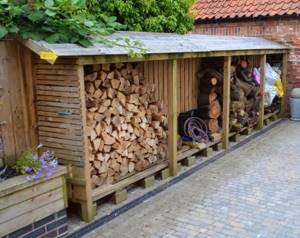
How to store wet firewood
For example, when purchasing and stacking firewood in April, the drying period will be 120 days. If you prepare them in June, drying will last longer - 310 days. Thus, you need to prepare firewood for the next season in winter.
The rules for storing firewood are:
- Firewood must be laid on a special ventilated flooring made of bricks or pallets. They should not be placed on the ground due to moisture absorption.
- It is better to place the woodpile against the wall of a fence, house, or barn to protect it from rain and blowing snow. There should be a roof on top.
- Firewood must be laid in layers, the top layer perpendicular to the bottom.
- When storing indoors, ventilation must be ensured; a pallet does not need to be built.
For proper drying, the main thing is that air flows to the firewood. Well-dried logs, when hit against each other, make a ringing sound.
In the absence of well-dried firewood, you can light the stove with raw firewood if you follow certain rules. It should be taken into account that it will take much more time to kindle the firewood itself. But the result will be achieved.
In this article I will talk about all possible problems with firing a stove, and also show a detailed video on firing and commissioning a wood-burning brick stove and more. How to light a stove, how to dry it, what kind of wood, how to light a stove in the fall, how to light it in the winter and many other options...
Pine firewood
Second most common after birch. The sauna, heated with pine wood, is quite hot and filled with a pleasant resinous aroma, thanks to which you can cure a cold, prevent inflammation of the respiratory tract, relax your nerves and find peace. However, it should be remembered that in such firewood, with a sharp increase in temperature, the resin sinuses burst - small cavities in the wood filled with resin. At the same time, a characteristic crackling sound occurs, sparks fly in all directions and the stove shoots small coals. It is better to add such firewood and mix it in special glasses to protect your eyes. To avoid a fire, after any manipulations with a stove filled with burning pine wood, you should definitely inspect the floor near it to make sure that a burning firebrand has not fallen out. It is better to combine pine firewood with aspen or alder to prevent the formation of resinous congestion in the chimney.
Rare types of firewood
Oak
– the best firewood for the stove. The wood is dense, burns for a long time, gives high heat transfer, and is very economical, because compared to other firewood, much less is consumed to heat the same area. Due to its high cost, it is often used as an additive to other wood. A pair of oak logs will make the burning more intense and longer.
Good oak firewood comes from middle-aged trees; when burned, they release a pleasant tart aroma. Oak firewood is ideal not only for stoves, but also for fireplaces.
Excellent, but also one of the most expensive - alder
firewood. They burn hot, without smoke or soot, spreading a pleasant aroma.
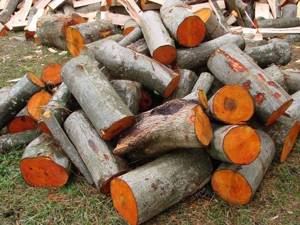
Alder cannot be confused with any other firewood; when cut, it has a color from yellow to deep red. Perhaps this is the best firewood for a fireplace; it burns with a mesmerizing, even flame of a beautiful color. A big plus is that alder firewood lasts a long time and can be stored for future use for 5-6 years.
Rare firewood includes linden
. Although linden is common, linden firewood is rare. The wood is hot, although it takes a long time to burn, but then the stove heats up very quickly. The aroma that comes from linden when burned has healing properties. A bathhouse heated with linden firewood is useful for colds, diseases of the bronchi and lungs, and has a beneficial effect on the condition of the skin.
Regardless of what type of firewood you purchase, make sure that the wood is not rotten. The benefits of rotten mushrooms are zero. In order for the wood to burn, giving off maximum heat, it must be dry. Undried wood burns poorly, produces a lot of smoke and little heat.
In the old days, firewood was considered a magical object, on the properties of which even the fate of those steaming depended. Today, the magical characteristics are substantiated by scientific data, the main of which are the ability to release more heat with less material consumption and the effect of released substances on the human body.
In our article we will talk about the main types of firewood for a bath, their features and differences. So, what kind of firewood will fill your bathhouse with real healing warmth?

